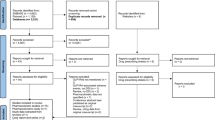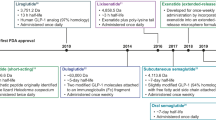Abstract
Purpose. The purpose of this study was to investigate the binding mechanism of loop diuretics with HSA and to characterize the binding site on HSA.
Methods. Quantitative analysis of potential interaction between ligands bound to HSA was performed by equilibrium dialysis and data for binding of the two ligands to HSA were analyzed on the basis of a theoretical model of simultaneous binding of two ligands.
Results. The binding of loop diuretics is dependent upon the N-B transition, conformational change of albumin. Furthermore, from the results of binding of the drugs to modified HSA, the lysine residue seems to be involved in the binding of loop diuretics to HSA.
Conclusions. Analysis using models describing independent, competitive, cooperative and anti-cooperative binding led to the conclusion that loop diuretics bind to site I, particularly to the warfarin region on HSA.
Similar content being viewed by others
REFERENCES
W. J. Jusco and M. Gretch. Plasma and tissue protein binding of drugs in pharmacokinetics. Drug Metab. Rev. 5:43–140, 1976.
U. Kragh-Hansen. Molecular aspects of ligand binding to serum albumin. Pharmacol. Rev. 33:17–53, 1981.
K. J. Fehske, W. E. Müller, and U. Wollert. The location of drug binding sites in human serum albumin. Biochem. Pharmacol. 30:687–692, 1981.
N. Takamura, M. H. Rahman, K. Yamasaki, M. Tsuruoka, and M. Otagiri. Interaction of benzothiadiazides with human serum albumin studied by dialysis and spectroscopic methods. Pharm. Res. 11:1452–1457, 1994.
G. Sudlow, D. J. Birkett, and D. N. Wade. Further characterization of two specific binding sites on human serum albumin. Mol. Pharmacol. 12:1052–1061, 1976.
K. Yamaoka, Y. Tanigawara, T. Nakagawa, and T. Uno. A pharmacokinetic analysis program (MULTI) for microcomputer. J. Pharmacobio-Dyn. 4:879–885, 1981.
S. Goto, H. Yoshitomi, A. Miyamoto, K. Inoue, and M. Nakano. Binding of several loop diuretics to serum albumin and human serum from patients with renal failure and liver disease. J. Pharmacobio-Dyn. 3:667–676, 1980.
J. Wilting, W. F. Van der Giesen, L. H. M. Janssen, M. M. Weideman, M. Otagiri, and J. H. Perrin. Effect of albumin conformation on the binding of warfarin to human serum albumin on the hydrogen, calcium and chloride ion concentration as studied by circular dichroism, fluorescence and equilibriam dialysis. J. Biol. Chem. 255:3032–3037, 1980.
K. Yamasaki, T. Maruyama, U. Kragh-Hansen, and M. Otagiri. Characterization of site I on human serum albumin: Concept about the structure of a drug binding site. Biochim. Biophys. Acta in press, 1996.
D. C. Carter and J. X. Ho. Structure of serum albumin. Adv. Pro. Chem. 45:153–203, 1994.
J. E. Walken. Lysine residue 199 of human serum albumin is modified by acethylsalicylic acid. FEBS Lett. 66:173–175, 1976.
J. T. Gerig and J. D. Reinheimer. Modification of human serum albumin with trifluoromethyl-substituted aryl halides and sulfonates. J. Am. Chem. Soc. 97:168–173, 1975.
O. J. M. Bos, J. F. A. Labro, M. J. E. Fisher, J. Wilting, and L. H. M. Janssen. The molecular mechanism of the neutral-to-base transition of human serum albumin acid/base transition and proton nuclear magnetic resonance studies on a large peptic and a large tryptic fragment of albumin. J. Biol. Chem. 264:953–959, 1989.
T. Sakai, A. Takadate, and M. Otagiri. Characterization for binding site of uremic toxins on human serum albumin. Biol. Pharm. Bull. 18:1755–1761, 1995.
C. F. Lim, J. R. Stockigt, A. J. Curtis, K. N. Wynne, J. W. Barlow, and D. J. Topliss. A naturally occuring furan fatty acid enhances drug inhibition of thyroxine binding in serum. Metabolism 42:1468–1474, 1993.
Author information
Authors and Affiliations
Rights and permissions
About this article
Cite this article
Takamura, N., Haruta, A., Kodama, H. et al. Mode of Interaction of Loop Diuretics with Human Serum Albumin and Characterization of Binding Site. Pharm Res 13, 1015–1019 (1996). https://doi.org/10.1023/A:1016098305796
Issue Date:
DOI: https://doi.org/10.1023/A:1016098305796




